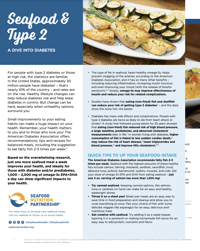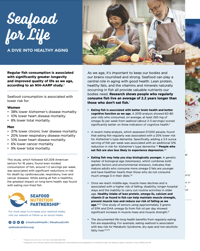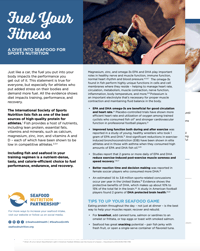シーフードと健康
健康で豊かな生活を
シーフードは栄養価が高いので、上手に活用することで食費を節約しながら健康に貢献することができます。

シーフードを多く摂ることで、体に栄養を与えることができます。
タンパク質: 筋肉や骨を作ったり修復したり、ホルモンや酵素を作ったりするのに使われます。また、エネルギー源としても利用されます。
オメガ3脂肪酸: DHAとEPAとしても知られています。これらの健康的な脂肪は、体内で作ることができないため、不可欠です。オメガ3系脂肪酸には、体を保護する効果や有益な作用があり、魚介類に自然に含まれています。オメガ3系脂肪酸を多く含む魚介類はこちら。
ビタミンD: カルシウムの吸収を助ける働きがあります。ビタミンDを含む食品はほとんどありませんが、マス、サケ、マグロ、サバなどの脂ののった魚に多く含まれています。
ビタミンB12: 細胞の代謝、神経機能、DNAの生成を助ける。
鉄: 健康な血液を維持し、成長・発達に必要な栄養素です。
セレン : 細胞をダメージから守る。
亜鉛: 免疫系が感染と闘うのを助けます。妊娠中、幼児期、児童期には、適切な成長と発達のために亜鉛が必要とされます。
ヨウ素: 体内で作ることができない必須ミネラルなので、食事やサプリメントで摂取する必要があります。食欲から免疫力までコントロールする健康的な代謝をサポートします。
魚を食べる頻度は?
米国農務省の「アメリカ人のための食生活指針」では、2000カロリーの食事に基づき、週に少なくとも226.8g(子供には少なめ)のシーフードを推奨しています。妊娠中や授乳中の女性は、水銀の少ない様々な種類の魚介類を週に226.8〜340.1g摂取すると効果的です。最も効果的なのは、様々な形や種類の魚介類を摂取することです。週2回以上食べるという目標を達成すると、様々な栄養素を摂取することができます。

-
心臓の健康
-
アメリカ心臓協会は、必須脂肪酸、タンパク質、ミネラル、脂溶性ビタミンの効果を得るために、週2食以上の脂身を含む魚介類の摂取を推奨しています。これらの栄養素は、心臓発作や心血管系疾患の予防に有効です
-
心臓病は、適切な食事、運動、生活習慣の改善により、80~90%予防可能であるというのは良いニュースです。1
-
魚介類は、低カロリーで良質なたんぱく質を含んでいます。脂肪分は魚介類の種類によって異なります。脂の乗ったものは心臓によい脂肪を含んでいるので、積極的に摂るようにしましょう。ビタミンやミネラルの効果を得るためにも、いろいろな種類の魚介類を食べるのがベストです。 より詳しく。
-
週に2回以上、揚げ物でない魚介類を選ぶ。
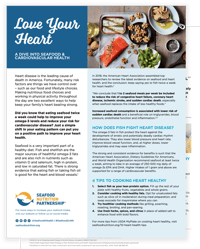
もっと詳しく: シーフードと心臓、血管の健康のために、あなたの心臓を気遣ってください。
ガイドを見る
-
-
母親と赤ちゃん
- 魚介類に含まれるオメガ3脂肪酸は、危険な早産を引き起こすリスクを劇的に低減します。早産は5歳未満の子どもの死亡原因の第1位であり、未熟児は長期的な発達の遅れのリスクが高くなります。2
- 魚介類には亜鉛が含まれており、妊娠中や乳幼児期には特に適切な成長と発達のために重要です。3
- 米国小児科学会は、子供と妊娠中または授乳中の女性は、週に1〜2食の魚を食べることを推奨しています。水銀の少ない魚を選ぶために、妊娠中はサメ、メカジキ、サバ、メバチマグロ、マカジキ、オレンジラフィーを避けましょう。
- 魚を食べることは、ストレスや苦痛を軽減することができます。妊婦を対象とした研究では、週に226.8〜340.1g(2〜3人前)の魚を食べることで、ストレスや産後のうつ病が軽減されたと報告されています。また、父親も定期的に魚を食べると、妊娠中の苦痛が軽減されました。4

もっと詳しく: 妊娠中の魚、女性の健康と乳児の予後を考える
ガイドを入手する
なぜ妊娠中や授乳中に魚は栄養価が高いのでしょうか?
もっと詳しく
なぜ魚は子供にとって栄養価が高いのでしょうか?
もっと詳しく
-
健康な子供達
- シーフードには、子どもの脳と心臓の健康を向上させる力があります。(出典:eatright.org)
- オメガ3脂肪酸は、受胎から生涯を通じて脳の構造を形成するのに役立つため、子供には脂肪の多い魚に含まれる貴重なオメガ3脂肪酸が必要です。
- 週に1回以上魚を食べる子どもは、学校の成績が良いようです。オメガ3脂肪酸は脳の発達を助け、IQの向上や読解力・スペル力の向上につながります。5
- 魚介類は目の健康な発育を助けます。魚介類に含まれるオメガ3は、光を感知する能力をサポートすることで、私たちの視力を助けます。6
- 魚介類は、特に成長期の発育に欠かせない赤身のタンパク質の優れた供給源です。タンパク質は、骨、皮膚、筋肉の継続的な成長と修復に必要です。
- 魚介類を多く摂取している子供たちは、魚介類に含まれる健康的な脂肪により、不安感が少なく、集中力が高いことが分かっています。
- 保育者は、良いお手本となり、定期的に一緒に魚介類の食事を楽しむことで、子どもの食習慣に良い影響を与えることができます。
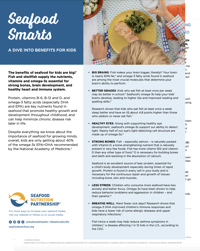
もっと詳しく: シーフード・スマート、子供のためのシーフードの効能を探る
ガイドを見る
-
メンタルヘルス
- DHAはオメガ3系脂肪酸の一種で、脳の機能を正常かつ効率的に維持するために必要な成分です。 これは、魚を買い物リストに追加することで実現できます。
- 魚を定期的に食べる人は、同世代の人たちよりもうつ病になる確率が20%低いことが分かっています。6, 10, 18, 19 週に226.8〜340.1g(約2〜3人前)の魚を食べると、うつ病のリスクが大幅に減ることはよく知られています。12 米国精神医学会も、魚に含まれる脂肪がうつ病治療に有効だと推奨しており、魚に含まれる脂肪は、うつ病の治療にも役立ちます。
- 魚にはビタミンD、マグネシウム、亜鉛が含まれていますが、これらはうつ病の人に少ないことが分かっている栄養素です。13-18
- 健康的な脂肪、タンパク質、亜鉛の摂取は、抗うつ薬への反応を改善することが示されています。6,10,19,20 米国精神医学会は、すべてのアメリカ人が週に2回以上、できればサーモンやトラウトなどの脂肪分の多い魚を食べるよう推奨しています。12
- オメガ3などの健康的な脂肪を増やし、ジャンクフードに含まれる脂肪を減らすことで、片頭痛の頻度、期間、重症度を大幅に減らせるという研究結果も出ています。20
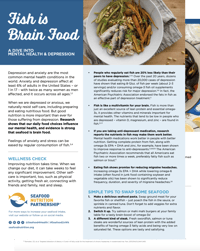
もっと詳しく: 魚はブレインフード、メンタルヘルスとうつ病に迫る
ガイドを見る
心臓の健康
-
アメリカ心臓協会は、必須脂肪酸、タンパク質、ミネラル、脂溶性ビタミンの効果を得るために、週2食以上の脂身を含む魚介類の摂取を推奨しています。これらの栄養素は、心臓発作や心血管系疾患の予防に有効です
-
心臓病は、適切な食事、運動、生活習慣の改善により、80~90%予防可能であるというのは良いニュースです。1
-
魚介類は、低カロリーで良質なたんぱく質を含んでいます。脂肪分は魚介類の種類によって異なります。脂の乗ったものは心臓によい脂肪を含んでいるので、積極的に摂るようにしましょう。ビタミンやミネラルの効果を得るためにも、いろいろな種類の魚介類を食べるのがベストです。 より詳しく。
-
週に2回以上、揚げ物でない魚介類を選ぶ。
もっと詳しく: シーフードと心臓、血管の健康のために、あなたの心臓を気遣ってください。
ガイドを見る
母親と赤ちゃん
- 魚介類に含まれるオメガ3脂肪酸は、危険な早産を引き起こすリスクを劇的に低減します。早産は5歳未満の子どもの死亡原因の第1位であり、未熟児は長期的な発達の遅れのリスクが高くなります。2
- 魚介類には亜鉛が含まれており、妊娠中や乳幼児期には特に適切な成長と発達のために重要です。3
- 米国小児科学会は、子供と妊娠中または授乳中の女性は、週に1〜2食の魚を食べることを推奨しています。水銀の少ない魚を選ぶために、妊娠中はサメ、メカジキ、サバ、メバチマグロ、マカジキ、オレンジラフィーを避けましょう。
- 魚を食べることは、ストレスや苦痛を軽減することができます。妊婦を対象とした研究では、週に226.8〜340.1g(2〜3人前)の魚を食べることで、ストレスや産後のうつ病が軽減されたと報告されています。また、父親も定期的に魚を食べると、妊娠中の苦痛が軽減されました。4
もっと詳しく: 妊娠中の魚、女性の健康と乳児の予後を考える
ガイドを入手する
なぜ妊娠中や授乳中に魚は栄養価が高いのでしょうか?
もっと詳しく
なぜ魚は子供にとって栄養価が高いのでしょうか?
もっと詳しく
健康な子供達
- シーフードには、子どもの脳と心臓の健康を向上させる力があります。(出典:eatright.org)
- オメガ3脂肪酸は、受胎から生涯を通じて脳の構造を形成するのに役立つため、子供には脂肪の多い魚に含まれる貴重なオメガ3脂肪酸が必要です。
- 週に1回以上魚を食べる子どもは、学校の成績が良いようです。オメガ3脂肪酸は脳の発達を助け、IQの向上や読解力・スペル力の向上につながります。5
- 魚介類は目の健康な発育を助けます。魚介類に含まれるオメガ3は、光を感知する能力をサポートすることで、私たちの視力を助けます。6
- 魚介類は、特に成長期の発育に欠かせない赤身のタンパク質の優れた供給源です。タンパク質は、骨、皮膚、筋肉の継続的な成長と修復に必要です。
- 魚介類を多く摂取している子供たちは、魚介類に含まれる健康的な脂肪により、不安感が少なく、集中力が高いことが分かっています。
- 保育者は、良いお手本となり、定期的に一緒に魚介類の食事を楽しむことで、子どもの食習慣に良い影響を与えることができます。
もっと詳しく: シーフード・スマート、子供のためのシーフードの効能を探る
ガイドを見る
メンタルヘルス
- DHAはオメガ3系脂肪酸の一種で、脳の機能を正常かつ効率的に維持するために必要な成分です。 これは、魚を買い物リストに追加することで実現できます。
- 魚を定期的に食べる人は、同世代の人たちよりもうつ病になる確率が20%低いことが分かっています。6, 10, 18, 19 週に226.8〜340.1g(約2〜3人前)の魚を食べると、うつ病のリスクが大幅に減ることはよく知られています。12 米国精神医学会も、魚に含まれる脂肪がうつ病治療に有効だと推奨しており、魚に含まれる脂肪は、うつ病の治療にも役立ちます。
- 魚にはビタミンD、マグネシウム、亜鉛が含まれていますが、これらはうつ病の人に少ないことが分かっている栄養素です。13-18
- 健康的な脂肪、タンパク質、亜鉛の摂取は、抗うつ薬への反応を改善することが示されています。6,10,19,20 米国精神医学会は、すべてのアメリカ人が週に2回以上、できればサーモンやトラウトなどの脂肪分の多い魚を食べるよう推奨しています。12
- オメガ3などの健康的な脂肪を増やし、ジャンクフードに含まれる脂肪を減らすことで、片頭痛の頻度、期間、重症度を大幅に減らせるという研究結果も出ています。20
もっと詳しく: 魚はブレインフード、メンタルヘルスとうつ病に迫る
ガイドを見る
より良い健康へのおいしい方法
手軽で簡単なシーフードレシピで、食生活にシーフードをプラスしてみませんか?
View Sources
* The Seafood Nutrition Partnership marks are registered service marks owned by SNP.
1 McGill HC, et al. Preventing Heart Disease in the 21st Century. Circulation, 2008;117:1216–1227.
2 Advice About Eating Fish for Those Who Might Become or are Pregnant or Breastfeeding and Children ages 1-11. Retrieved Jul 2, 2022, from http://www.fda.gov/food/consumers/advice-about-eating-fish.
3 Zinc Fact Sheet for Health Professionals. Retrieved Jul 2, 2022, from https://ods.od.nih.gov/factsheets/Zinc-HealthProfessional/
4 Hamazaki K, et al. Dietary intake of sh and n-3 polyunsaturated fatty acids and risks of perinatal depression: The Japan Environment and Children’s Study (JECS). J Psychiatr Res, 2018;98:9-16.
5 Kuratko CN, et al. The relationship of docosahexaenoic acid (DHA) with learning and behavior in healthy children: a review. Nutrients. 2013;5(7):2777–2810.
6 Grosso G, et al. Dietary n-3 PUFA, sh consumption and depression: A systematic review and meta-analysis of observational studies. J A ect Disord, 2016;205:269-281.
7 Li F, Liu X, Zhang D. Fish consumption and risk of depression: A meta-analysis. J Epidemiol Comm Health, 2016;70(3):299-304.
8 Sanchez-Villegas A, et al. Long chain omega-3 fatty acids intake, sh consumption and mental disorders in the SUN cohort study. Eur J Nutr, 2007;46(6):337-346.
9 McNamara RK. Role of omega-3 fatty acids in the etiology, treatment, and prevention of depression: Current status and future directions. J Nutr Intermed Metab, 2016;5:96-106.
10 Hibbeln JR. Fish consumption and major depression. Lancet, 1998;351:1213.
11 Sánchez-Villegas A, et al. Seafood Consumption, Omega-3 Fatty Acids Intake, and Life-
12 Freeman MP, et al. Omega-3 fatty acids: Evidence basis for treatment and future research in psychiatry. J Clin Psychiatry, 2006;67:1954-1967.
13 Thesing CS, et al. Omega-3 and omega-6 fatty acid levels in depressive and anxiety disorders. Psychoneuroendocrin, 2018;87:53-62.
14 Swardfager W, et al. Zinc in depression: A meta-analysis. Biol Psychiatry, 2013;74(12):872-878.
15 Wang J, Um P, Dickerman, BA. Zinc, magnesium, selenium and depression: A review of the evidence, potential mechanisms and implications. Nutrients, 2018;10(5):584.
16 Jacka FN, et al. Association between magnesium intake and depression and anxiety in community-dwelling adults: The Hordaland Health Study. Aust N Z J Psychiatry, 2009;43(1):45-52.
17 Wilkins, CH, et al. Vitamin D de ciency is associated with low mood and worse cognitive performance in older adults. Am J Geriatr Psychiatry, 2006;14(12):1032-1040.
18 Polak MA, et al. Serum 25-hydroxyvitamin D concentrations and depressive symptoms among young adult men and women. Nutrients, 1914;6(11):4720-4730.
19 Gertsik, L, et al. Omega-3 fatty acid augmentation of citalopram treatment for patients with major depressive disorder. J Clin Psychopharmacol, 2012;32(1):61-64.
20 Ramsden, CE, et al. Targeted alteration of dietary n-3 and n-6 fatty acids for the treatment of chronic headaches: A randomized trial. Pain, 2013;154(11):2441-2451.
21 Moza arian D, et al. Plasma phospholipid long-chain omega-3 fatty acids and total and cause-specific mortality in older adults: A cohort study. Ann Intern Med 2013;158(7):515-525.
22 Burkhart SJ, Pelly FE. Dietary Intake of Athletes Seeking Nutrition Advice at a Major International Competition. Nutrients 2016;8(10). E638.
23 Volpe SL. Magnesium and the Athlete. Curr Sports Med Rep 2015;14(4):279-283.
24 Ochi E, Tsuchiya Y. Eicosapentaenoic Acid (EPA) and Docosahexaenoic Acid (DHA) in Muscle Damage and Function. Nutrients 2018;10(5).pii:E552.
25 Sikora-Klak J, et al. The Effect of Abnormal Vitamin D Levels in Athletes. Perm J 2018;22:17-216.
